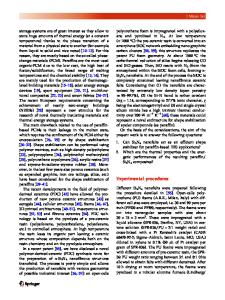R -Curve Behavior of Si 3 N 4 /BNNT Composites
- PDF / 882,472 Bytes
- 14 Pages / 439.37 x 666.142 pts Page_size
- 8 Downloads / 361 Views
R-Curve Behavior of Si3N4/BNNT Composites Hang-Hai Yu & Shou-Ren Wang & Li-Ying Yang
Received: 30 July 2012 / Accepted: 6 January 2013 / Published online: 26 February 2013 # Springer Science+Business Media Dordrecht 2013
Abstract The crack propagation rsistance behavior of Si3N4 ceramics reinforced by boron nitride nanotubes (BNNT) has been discussed in the work. And, bending strength and fracture toughness of Si3N4/BNNT composites were tested by three point bending method. It is shown that crack propagation resistance of BNNT/Si3N4 composites is increased distinctly owing to addition of BNNT. It is attributed to the pinning and bridging roles of BNNT. One kind of mathematical model was constructed for calculating crack propagation resistance of Si3 N4 ceramics and BNNT/Si3 N4 composites. Crack resistance curve (R-Curve) of Si3N4 ceramics and BNNT/Si3N4 composites was also calculated. Crack propagation of them was simulated using finite element methods. The results show that strong shielding area is formed in crack tip owing to existence of BNNT and crack propagation is prevented by strong stress shielding roles. Keywords Si3N4 ceramics . Boron nitride nanotubes . Composites . Finite element . Crack propagation resistance behavior
1 Introduction Si3N4 ceramic is widely used in mechanical, chemical, aerospace and other fields because of its high strength and hardness, high temperature and corrosion resistance, excellent oxidation and thermal shock resistance, as well as high heat conductivity and low density, and so on [1, 2]. However, as ceramic materials, its intrinsic brittleness leads to a drastic decrease of electromechanical properties or device failure of Si3N4 ceramics. And enhancing the fracture toughness becomes a main key of improving the reliability of Si3N4 ceramics. Toughening behavior of ceramics composites is attributed to increasing crack resistance in crack tip shielding area. Fracture toughness of fiber reinforced ceramic matrix composites is usually described by crack resistance curve (R-Curve) behavior which is to point to increasing crack propagation resistance with the increase of the crack dimensions in the H.-H. Yu : S.-R. Wang (*) : L.-Y. Yang School of Mechanical Engineering, University of Jinan, Jinan, Shandong 250022, China e-mail: [email protected]
948
Appl Compos Mater (2013) 20:947–960
steady-state crack propagation process [3, 4]. Self-enhancement, adding particle or whisker and so on is already used to toughen Si3N4 ceramics. However, the results are limited [5]. Fiber toughening is also a kind of important method for Si3N4 ceramics [6]. Some toughening mechanism, such as crack deflection, bridging, pinning and so on are usually discussed in the fracture process of Si3N4 ceramics. The crack resistance of Si3N4 ceramics is improved distinctly owing to addition of fibers [7, 8]. Boron nitride nanotubes (BNNT) is considered as a kind of hollow short fibers. It has good chemical stability, excellent mechanical properties and heat conduction performance, low thermal expansion perf
Data Loading...











